Space for oddities
by all | 27 February 2014 4:00 pm
 [1]
[1]Photos ©The David Bowie Archive, courtesy AGO
By Peter Saunders
Last fall, the Art Gallery of Ontario (AGO) hosted the North American debut of ‘David Bowie is,’ a new hit exhibition organized by the Victoria and Albert (V&A) Museum in London, England. From September 25 to November 29, 2013, the Toronto venue hosted more than 300 objects from the famous, groundbreaking British pop musician’s personal archive, including iconic stage costumes, audio recordings, notes, sketches, photos, lithographs, posters, set designs, album artwork, interviews and video footage, spanning the five decades since Bowie was a teenager.
As the first stop on the exhibition’s world tour, the AGO was something of a testing ground for adapting the V&A’s multimedia experience—which the New York Times described as “unified in sound and vision in a way rarely seen in a museum”—so it can be hosted in other facilities.
“We are thrilled to work with the V&A in bringing the provocative vision of David Bowie to Toronto,” said Matthew Teitelbaum, director and CEO of the AGO. “This is a once-in-a-lifetime opportunity to celebrate a living artist who has had an enormous influence on design and contemporary culture. His willingness to defy genres has made his career a barometer for cutting-edge performance art.”
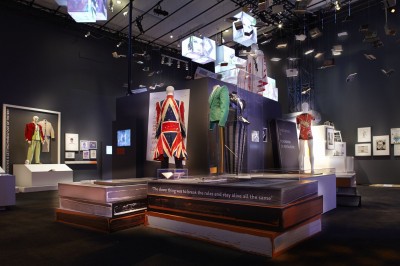 [2]
[2]Based on designs sent from England, Toronto-based Holman Exhibits printed vinyl graphics and wrapped them on oversized ‘books’ for the AGO exhibition.
With the opportunity came a significant challenge, however, as 14 exhibit areas on the fourth and fifth floors of the AGO’s contemporary tower needed to be built out with extensive display walls, cases and other structures. Toronto-based Holman Exhibits, already a trusted partner to the AGO, was called upon to manage this fabrication and installation work under tight timelines. A dedicated 45-member team assigned to the project kept it on track over an eight-week period.
“The whole schedule was driven by the opening day,” says Chris Marshall, senior manager for Holman.
Unlike any other
The exhibition’s run at the V&A marked the first time any museum has been allowed to display items from Bowie’s archive. Victoria Broackes and Geoffrey Marsh, the V&A’s theatre and performance curators, worked with Sandy Hirshkowitz, the archivist for Bowie’s collection, to carefully select costumes, objects and footage for the exhibition. The curators never met Bowie himself.
“He doesn’t throw things away,” says Broackes. “Ever since David Robert Jones started to construct the identity of David Bowie in 1967, he’s been curating himself, celebrating many different personalities. We wanted that creative spirit in our exhibition’s design—it shouldn’t be like any other museum exhibit.”
‘David Bowie is’ sold more than 67,000 advance tickets and attracted more than 300,000 visitors during its five-month run at the V&A, breaking all previous records. Broackes and Marsh also co-edited and contributed to a book associated with the exhibition, which in turn is the first permanent volume authorized by and permitted full access to Bowie’s archive.
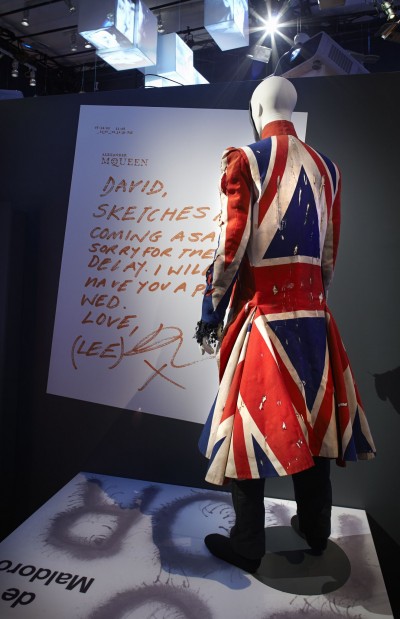 [3]
[3]The exhibition placed a strong emphasis on David Bowie’s many stage costumes. Custom mannequins had to be manufactured with Bowie’s 26-inch waist.
Adapting designs
When the time came to bring the exhibition to Toronto, much of the V&A experience had to be recreated, since only the artifacts themselves were being sent over, not the various temporary structures that displayed them.
“Each room in the exhibition was like a box,” says Edgars Apse, Holman’s marketing manager. “Our structures added depth, projection surfaces and paths to all of the artifacts. We fabricated and installed all of the cabinetry, display surfaces and temporary walls. Several pieces involved printing and applying vinyl graphics.”
These included oversized ‘books’ that were wrapped with full-colour graphics produced with Holman’s new flatbed printer. All of these were based on designs sent over from England.
“The exhibition was redesigned for the AGO and we received three-dimensional (3-D) modelling files,” explains Holman’s Marshall. “It was a bit of a challenge, because the company that designed it in England didn’t build it. We got the new design drawings, then the V&A’s fabrication drawings, and had to figure out which would work best.”
The AGO also produced some signage itself, printing text onto graphic panels, which allowed its curators to control all of the messaging.
“These were small enough pieces that they could create them at their internal workshop,” Marshall explains.
With a compressed schedule, the fabrication and installation process had to be streamlined, so communications channels were opened with the AGO to expedite approvals. The various pieces were built at Holman’s facility, then assembled on-site at the AGO, where adjustments could be made as required.
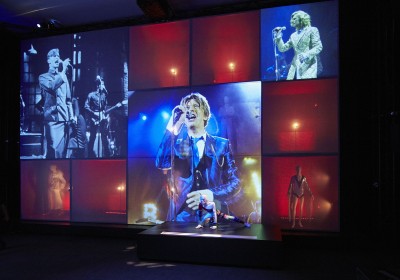 [4]
[4]To showcase concert footage, a video wall was assembled using plywood lightboxes with fabric covers. When the lighting changed, visitors could see artifacts inside the boxes.
“It was too big to do everything here,” says Marshall. “We had to assemble and repaint components on-site. I had six installers down there working 12 hours a day, for six days a week, for three weeks.”
The extensive repainting was necessary because almost all display components are flat black, so it was inevitable they would gather dust during fabrication, shipping, handling, positioning and installation.
“You can’t wipe it off,” says Marshall.
Throughout the installation process, as soon as Holman finished its work, another team would come in to add lighting, electronics, audio and other systems to the infrastructure.
Matching projections
The most technically challenging aspect of the exhibition was its heavy use of digitally projected content. The original design team in England sent 20 employees to Toronto to make sure all systems were installed properly, as ceiling-mounted projectors had to throw images with sharp precision onto complex surfaces. One zone, for example, represented Bowie’s childhood bedroom with dynamic images of his various artistic influences appearing on dimensional faces.
“The audiovisual (AV) team had handled the opening ceremonies for the 2012 Summer Olympics in London, so they were very good to work with,” says Marshall.
In another room, an enormous wall showcased concert footage across a series of illuminated ‘steel cages’—actually plywood lightboxes, but using steel back panels—with fabric covers.
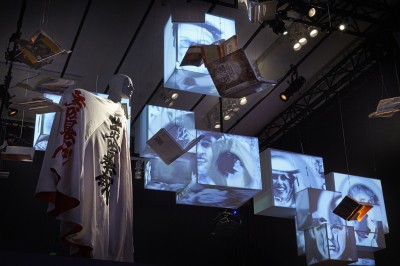 [5]
[5]Among the biggest fabrication challenges were white ‘boxes’ that hung from the ceiling, with images projected onto their exterior surfaces.
“When you project an image from outside and the light inside is turned off, you can’t see in,” Marshall explains, “and when there’s no projection from outside and the light inside is turned on, you can.”
As the AGO’s floor plan differs from the V&A’s, these lightboxes had to be redesigned, making them lower and wider than the original taller versions. Hence, the digital projections were reconfigured to match.
Finally, another zone featured white ‘boxes’ hanging from the ceiling, with images projected onto their exterior surfaces.
“Those were really difficult to draw, build and install in clusters in very specific ways,” says Marshall. “They were one of the last jobs we tackled.”
Sound all around
One of the integral elements of the touring exhibition is a sound experience designed by Sennheiser, known for manufacturing microphones, headphones and wireless transmission systems.
“For me, Bowie has always been more than a one-dimensional artist,” says Daniel Sennheiser, president of strategy and finance. “He paved the way for self-expression and artistic freedom, so it is only right to celebrate him at the AGO. Our sister company Neumann’s microphones were used on most Bowie albums and I am thrilled we are involved with ‘David Bowie is,’ as a partner and as the provider of the audio guide system and a 3-D sound experience.”
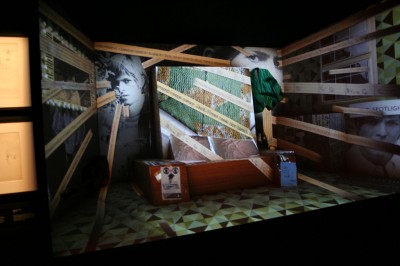 [6]
[6]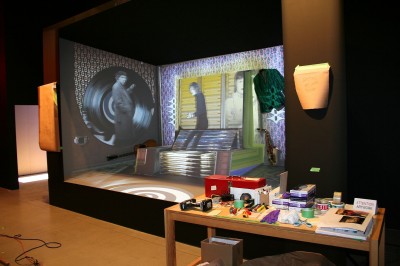 [7] One zone represented Bowie’s childhood bedroom, with dynamic images of his artistic influences projected onto varying planes. The original design team from England visited Toronto to ensure the images were correctly aligned to the physical structures. Photos by Edgars Apse, Holman Exhibits
[7] One zone represented Bowie’s childhood bedroom, with dynamic images of his artistic influences projected onto varying planes. The original design team from England visited Toronto to ensure the images were correctly aligned to the physical structures. Photos by Edgars Apse, Holman Exhibits
While many museum exhibitions have offered audio guides in the past, ‘David Bowie is’ requires them, as they provide both tour information and all of the exhibition’s soundtracks, which automatically play as a visitor approaches an exhibit, enabling him/her to enjoy an individual experience.
The 3-D sound, meanwhile, is played through hidden speakers in two zones: a collage of Bowie songs arranged by his producer, Tony Visconti, and the aforementioned huge screen installation showcasing concert footage.
“My aim has been to turn stereo sound into immersive surround sound,” says Gregor Zielinsky, Sennheiser’s international recording applications manager. “To achieve this, I developed an algorithm to convert Bowie’s mono and stereo material into multi-channel music. The algorithm uses spatial information to convert the recordings and simulate 3-D sound. I controlled and co-ordinated the conversion. Each song took two days of work in the studio.”
“This is magic to me,” says Visconti. “I don’t know how they do it. Sounds are coming from over my head, down by my feet, over my right shoulder, over my left shoulder, in front of me, to the sides.”
“Sennheiser created a truly immersive experience,” says the AGO’s Teitelbaum.
Fittingly, one of the media partners for the Toronto exhibition was classic rock radio station Q107.
Going on tour
Following its run in Toronto, ‘David Bowie is’ is scheduled to visit the Museum of Image and Sound in Sao Paolo, Brazil, from January 28 to April 21, 2014; the Museum of Contemporary Art in Chicago, Ill., from September 2014 to January 2015; la Philharmonie de Paris/Cité de la Musique in Paris, France, from March to May 2015; and the Groninger Museum in Groningen, The Netherlands, from December 2015 to March 2016.
With files from Holman Exhibits. For more information, visit www.holmanexhibits.com[8].
- [Image]: http://www.signmedia.ca/wp-content/uploads/2014/02/1-Area-5-Astronauts-of-Inner-Space.jpg
- [Image]: http://www.signmedia.ca/wp-content/uploads/2014/02/2-Area-9-Collaboration-Non-musical.jpg
- [Image]: http://www.signmedia.ca/wp-content/uploads/2014/02/3-Area-9-Union-Jack-Coat.jpg
- [Image]: http://www.signmedia.ca/wp-content/uploads/2014/02/8-Area-14-Yamamoto-Catsuit-1973.jpg
- [Image]: http://www.signmedia.ca/wp-content/uploads/2014/02/7-Area-6-Cultural-Influences-Cloak-with-Kanji-Letters.jpg
- [Image]: http://www.signmedia.ca/wp-content/uploads/2014/02/IMG_4493.jpg
- [Image]: http://www.signmedia.ca/wp-content/uploads/2014/02/IMG_4402.jpg
- www.holmanexhibits.com: http://www.holmanexhibits.com
Source URL: https://www.signmedia.ca/space-for-oddities/